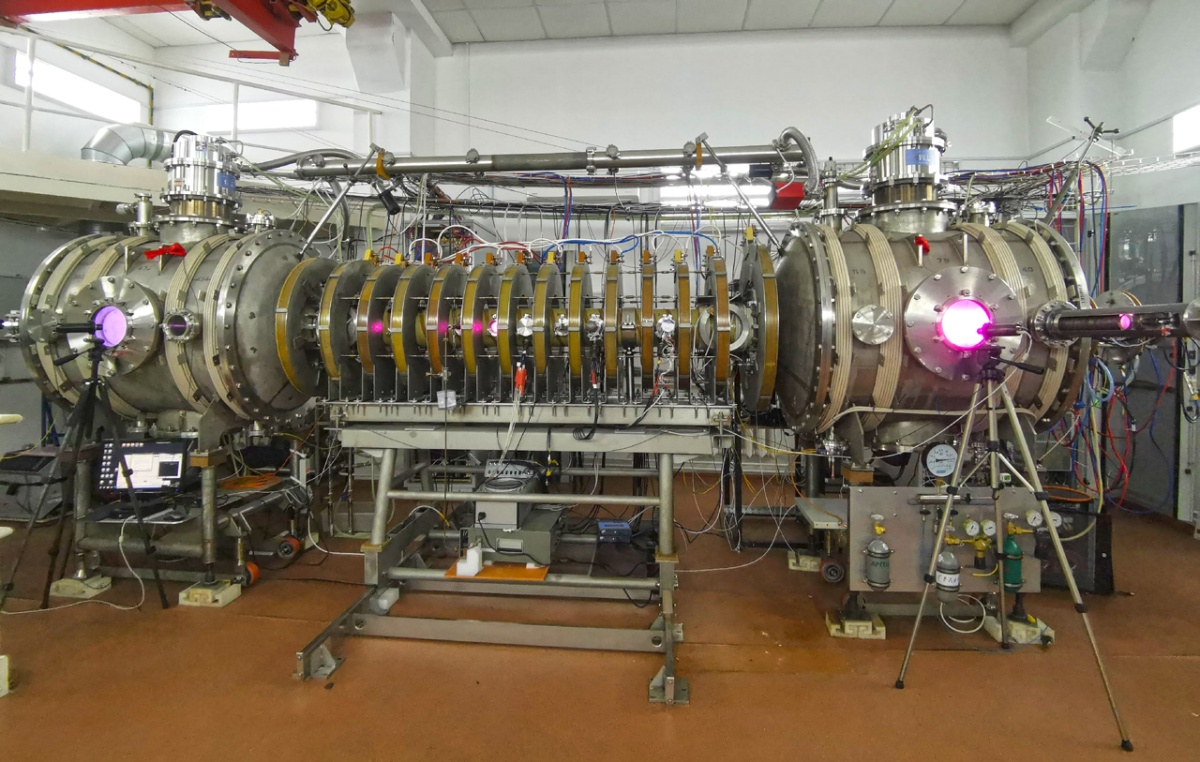
The GI Budker Institute of Nuclear Physics of the Siberian Branch of the Russian Academy of Sciences (INP SB RAS) has succeeded in increasing the plasma density by 1.5 times in its SMOLA fusion facility. It also slowed down plasma outflow by 10 times. Research in the field of controlled thermonuclear fusion is being carried out using experimental facilities based on various magnetic confinement systems. They all have the same goal - to achieve the temperature, density and plasma confinement time necessary for thermonuclear fusion.
While many fusion projects, including the International Thermonuclear Experimental Reactor (ITER) in France, use a closed-type magnetic trap for the plasma - a tokamak - others use open magnetic traps. Researchers at INP use several open type experimental facilities, including SMOLA, which is an open trap with a spiral magnetic plasma confinement. The scientists recently published two scientific papers detailing the results of their experiments in the Journal of Plasma Physics.
One of the advantages of open systems is that they, unlike tokamaks, they can achieve a high ratio of plasma pressure to magnetic field pressure. Specialists from the INP have already managed to achieve a ratio of 0.6 and are striving to reach unity. However, while open magnetic traps are simple in geometry, similar to a bottle with two necks, they permit a strong outflow of plasma at the end holes. To solve the problem INP developed and built its experimental SMOLA (Spiral magnetic open trap) facility.
“The lines of force of the magnetic field in open traps are not closed, as, for example, in tokamaks, therefore, the plasma is retained only in the middle of the installation, and can flow out at the ends,” explained senior researcher Anton Sudnikov. To reduce this outflow magnetic “plugs” are put in place that increase the magnetic field. At another INP facility, RESIN, a different type of magnetic plug was tried. “RESIN differs from other open traps in that at one end, instead of the usual magnetic plug, we installed a screw plug. It is the helical magnetic field that can ‘drag’ the outflowing plasma back to the centre of the trap,” Sudnikov said.
In recent experiments using a strong helical magnetic field INP specialists were able to reduce the flow of the outflowing plasma to such an extent that they could no longer register it. “Theory predicts that in the presence of a helical field, plasma confinement should be enhanced. This is what we observed in the experiment,” Sudnikov noted. “But the most important result of our experiments… is that when a helical field is added, the plasma density also increases by 1.5 times. The dependence is simple: the more the plasma is confined in the trap, the denser it becomes, and the more efficient our entire multi-mirror system with screw confinement works in general.”
Thanks to the results obtained, scientists were able to move further in the study of controlled thermonuclear fusion. Thus, for example, at thermonuclear parameters of a plasma, for its effective confinement in a multiple-mirror trap, it is necessary that the ions collide and scatter more frequently. But with useful thermonuclear parameters, this just does not happen - the ion is scattered by other ions too rarely and can fly through the trap, then even the helical field will not pull it back.
INP scientists have since made further progress towards controlled fusion using another open trap facility – the GOL-3 (corrugated open trap. The next major step will be the development of an installation for confining thermonuclear plasma using a gas dynamic magnetic trap (GDML). INP hopes the GDML will demonstrate the possibility of designing a compact, economically and environmentally attractive thermonuclear reactor based on open-type magnetic traps.
“The letter ‘M’ in GDML means that the trap will be multimirror. In the basic version, this is just a magnetic field constricted by magnetic plugs. But if all our new achievements are applied in this project, then it will be possible to add a screw plug at the ends of the GDML, as on RESIN,” Sudnikov said. “The results of our experiments allow us to hope that the screw sections will increase efficiency. The size and complexity of the facility will remain the same, but we will increase the density and improve the quality of confinement and, accordingly, we will be closer to the fusion parameters that we need.”